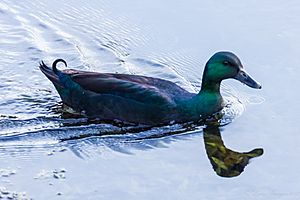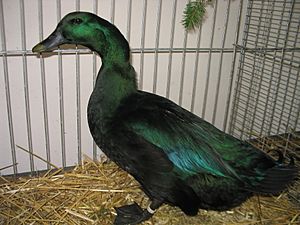Cayuga duck facts for kids

A Cayuga drake
|
|
| Conservation status |
|
|---|---|
| Other names |
|
| Country of origin | United States |
| Use |
|
| Traits | |
| Weight |
|
| Egg color | variable, black to pale green/blue |
| Classification | |
| APA | medium |
| EE | yes |
| PCGB | heavy |
|
|
The Cayuga duck is a beautiful domestic duck breed from America. It first appeared around 1840 in the Finger Lakes area of New York State. This duck is named after the Cayuga people, who are native to that region. For many years, the Cayuga was the main duck raised for meat in the United States. Today, people mostly keep them as pets or for their striking looks.
Contents
Discovering the Cayuga Duck's Story
Where Did Cayuga Ducks Come From?
The exact beginnings of the Cayuga duck are a bit of a mystery. Some people thought they might have come from the American Black Duck. However, scientists have not found proof for this idea.
Cayuga ducks are truly black, which is a common color change in ducks that come from the Mallard. The Cayuga also has a special curled feather in the tail of the male ducks, just like Mallards. The American Black Duck does not have this feather. This suggests that Cayuga ducks are related to Mallards, like most other domestic ducks.
How the Cayuga Duck Got Its Name
Around 1840, a man named John S. Clark found some of these ducks in Orange County, New York. He brought them to Cayuga County, which is in the Finger Lakes region. The breed was then named after the Cayuga people, who are the native people of that area.
The Cayuga Duck's Popularity Over Time
The Cayuga duck was officially recognized in 1874 in the first American Standard of Perfection. This book describes what different animal breeds should look like. In 1851, Cayuga ducks were first sent to the United Kingdom.
During the second half of the 1800s, the Cayuga became the most important duck breed for meat in the United States. But by about 1890, another duck, the American Pekin, became more popular. The Pekin duck was easier to prepare for sale because it didn't have dark pinfeathers like the Cayuga.
Today, the Cayuga duck is not considered "at risk" globally by the FAO. However, in the United States, organizations like The Livestock Conservancy keep an eye on their numbers. In 2008, they were listed as "threatened," but by 2020, their status improved to "watch."
What Do Cayuga Ducks Look Like?
The Cayuga is a medium to large duck. Adult male ducks, called drakes, usually weigh about 3.6 kilograms (8 pounds). Female ducks weigh about 3.2 kilograms (7 pounds).
Their feathers are black with a beautiful shiny green color, like a beetle. As ducks get older, especially females, some of their feathers might turn white. This can be a problem if they are being shown in a poultry show. Their bill, legs, and feet are black, and their eyes are dark brown.
How Cayuga Ducks Are Used Today
Meat and Eggs
In the past, the Cayuga was mainly raised for meat. However, the American Pekin duck became more popular because its lighter feathers made it easier to clean for market.
Today, Cayuga ducks are still raised for meat and eggs. But they are most often kept as pets or for showing in poultry shows. Female Cayuga ducks can lay about 100 to 150 large eggs each year. When they first start laying, their eggs can be very dark, almost black. As the laying season continues, the eggs become lighter, turning a pale greenish-blue or even almost white. If you want to hatch their eggs, it takes about 28 days for them to hatch.
Other Uses
The beautiful feathers of the Cayuga duck are also used to make fishing flies. These flies are used by people who enjoy fishing.


